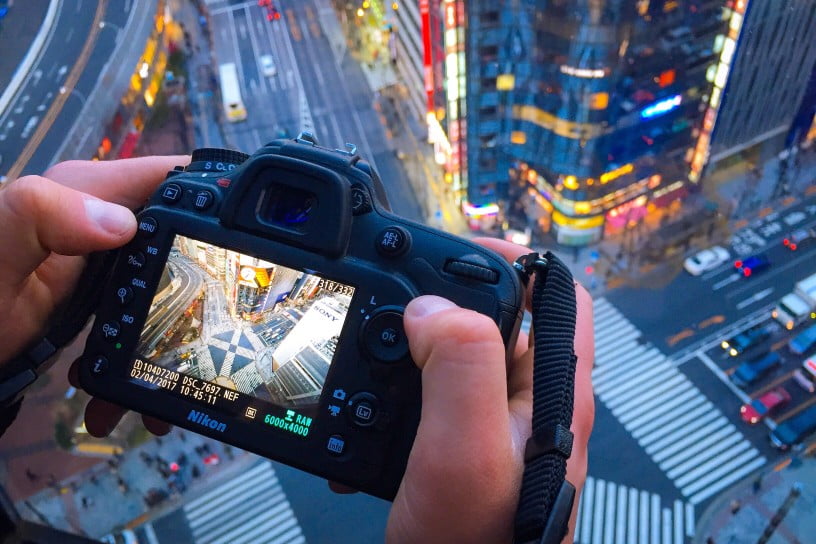If you are shopping for a new digital camera, you may be wondering about camera image stabilization optical vs digital. The best digital cameras, after all, typically feature one or even both of these stabilization techniques. Keep reading to learn about the differences between the two.
KEY TAKEAWAYS:
- Optical image stabilization uses mechanical parts, such as gyroscopes, to physically move the lens to stabilize the image.
- Digital image stabilization uses software and algorithms to complete this task. Optical image stabilization is typically considered the more effective choice.
- However, cameras equipped with true optical stabilization systems tend to cost more than those with an electronic image stabilization system.
What is Image Stabilization?
Image stabilization technology is a blanket term that refers to a variety of techniques that looks to limit blur and choppiness due to having unsteady hands as you take a photo. This is especially important if you are snapping photos without the use of a tripod or while in a moving vehicle. Most modern cameras include some type of image stabilization, even smartphone cameras, which can be important if you are comparing a cell phone camera vs a digital camera.
Insider Tip
Be sure to check the settings menu to access any image stabilization system.
Differences Between Optical and Digital Image Stabilization
The primary difference between these two techniques is how they stabilize images during use. Optical image stabilization uses dozens of mechanical gyroscopes that actually move the lens around to stabilize the image as you shoot. A stabilization method is considered optical if there is a mechanical element. This is occasionally referred to as lens-based stabilization, as the mechanical components are typically housed in the lens element.
Digital image stabilization, on the other hand, uses algorithms and software to keep your shots steady and free from blur. It uses pixels from beyond the frame as a motion buffer of sorts.
Effectiveness
In most cases, optical image stabilization is the better choice, as it works quickly, efficiently, and without error. This is due to the mechanical nature of the design. Of course, optical image stabilization is typically reserved for high-end DSLR cameras, so if you are comparing digital sensor size in DSLR cameras, you should also take a look at what kind of image stabilization is on offer.
Price
Optical image stabilization is more expensive than digital image stabilization, as the former uses actual mechanical components and the latter uses just software. In other words, a camera with true optical stabilization will cost more than one without this feature. On that note, make sure your camera has actual optical stabilization, as many companies use proprietary names and brandings to obscure what kind of stabilization is at work underneath the hood. Do some research before buying some new digital cameras.
F.A.Q.S
How do image stabilization systems work?
Different digital cameras include different stabilization systems, each with its own methods of operation.
When to turn image stabilization off?
When it comes to digital cameras, turn image stabilization off if you want a particular aesthetic or visual effect that will be rendered null by the stabilization system. You can also turn it off to conserve battery life or to avoid slower shutter speeds.
What is the best shutter speed when handholding?
When holding your camera by hand, set the shutter speed faster than one over your focal length. This is called the reciprocal rule and should be followed by most digital cameras, even if you are using telephoto lenses.
STAT: A rule of thumb to determine the slowest shutter speed possible for hand-holding without noticeable blur due to camera shake is to take the reciprocal of the 35 mm equivalent focal length of the lens, also known as the “1/mm rule (source)



































![Best Point and Shoot Camera in [year] ([month] Reviews) 27 Best Point and Shoot Camera in 2026 (January Reviews)](https://www.gadgetreview.dev/wp-content/uploads/Nikon-Coolpix-B500.jpg)
![Best Underwater Camera in [year] ([month] Reviews) 28 Best Underwater Camera in 2026 (January Reviews)](https://www.gadgetreview.dev/wp-content/uploads/best-underwater-camera-image.jpg)
![Best Digital Cameras in [year] ([month] Reviews) 29 Best Digital Cameras in 2026 (January Reviews)](https://www.gadgetreview.dev/wp-content/uploads/what-is-resolution-on-digital-camera-1.jpg)
![Best Digital Camera Docking Stations in [year] 30 Best Digital Camera Docking Stations in 2026](https://www.gadgetreview.dev/wp-content/uploads/best-digital-camera-docking-stations-image.jpg)
![Best Vlogging Camera in [year] ([month] Reviews) 31 Best Vlogging Camera in 2026 (January Reviews)](https://www.gadgetreview.dev/wp-content/uploads/best-vlogging-camera-image.jpg)
![Best Mirrorless Camera in [year] ([month] Reviews) 32 Best Mirrorless Camera in 2026 (January Reviews)](https://www.gadgetreview.dev/wp-content/uploads/best-mirrorless-camera-image.jpg)
![Best GoPro in [year] ([month] Reviews) 33 Best GoPro in 2026 (January Reviews)](https://www.gadgetreview.dev/wp-content/uploads/best-gopro-image.jpg)
![Best Digital Camera Tripods in [year] 34 Best Digital Camera Tripods in 2026](https://www.gadgetreview.dev/wp-content/uploads/best-digital-camera-tripods-image.jpg)
![Best Canon Digital Cameras in [year] 35 Best Canon Digital Cameras in 2026](https://www.gadgetreview.dev/wp-content/uploads/best-canon-digital-cameras-image.jpg)
![Best Polaroid Digital Cameras in [year] 36 Best Polaroid Digital Cameras in 2026](https://www.gadgetreview.dev/wp-content/uploads/best-polaroid-digital-cameras-image.jpg)
![Best Small Digital Camera Cases in [year] 37 Best Small Digital Camera Cases in 2026](https://www.gadgetreview.dev/wp-content/uploads/best-small-digital-camera-case-image.jpg)
![Best Digital Camera USB Cables in [year] 38 Best Digital Camera USB Cables in 2026](https://www.gadgetreview.dev/wp-content/uploads/best-digital-camera-usb-cable-image.jpg)
![Best Digital Camera Bags in [year] 39 Best Digital Camera Bags in 2026](https://www.gadgetreview.dev/wp-content/uploads/best-digital-camera-bag-image.jpg)
![Best Sony Digital Cameras in [year] 40 Best Sony Digital Cameras in 2026](https://www.gadgetreview.dev/wp-content/uploads/best-sony-digital-cameras-image.jpg)
![Best Panasonic Digital Cameras in [year] 41 Best Panasonic Digital Cameras in 2026](https://www.gadgetreview.dev/wp-content/uploads/best-panasonic-digital-cameras-image.jpg)
![Best Digital Camera Accessories in [year] 42 Best Digital Camera Accessories in 2026](https://www.gadgetreview.dev/wp-content/uploads/best-digital-camera-accessories-image.jpg)
![Best Kodak Digital Cameras in [year] 43 Best Kodak Digital Cameras in 2026](https://www.gadgetreview.dev/wp-content/uploads/best-kodak-digital-cameras-images.jpg)
![Best Video Cameras in [year] ([month] Reviews) 44 Best Video Cameras in 2026 (January Reviews)](https://www.gadgetreview.dev/wp-content/uploads/best-video-cameras-image.jpg)
![Best Compact Cameras in [year] 45 Best Compact Cameras in 2026](https://www.gadgetreview.dev/wp-content/uploads/best-compact-camera-image.jpg)
![Best Digital Cameras with Wifi in [year] 46 Best Digital Cameras with Wifi in 2026](https://www.gadgetreview.dev/wp-content/uploads/best-digital-camera-with-wifi-image.jpg)



















